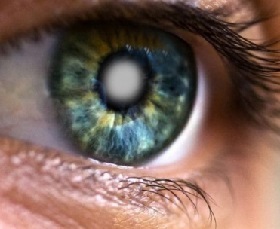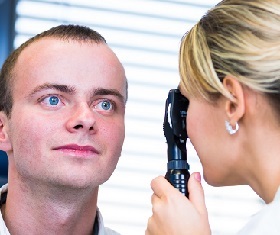 Cataract is a clouding of the lens - an optical lens that is located inside the eye. The name of the disease came from the Greek word katarrháktes, which means "waterfall".This is due to the views of ancient healers that the disease develops as a result of the flow of turbid fluid between the iris and the lens.
Cataract is a clouding of the lens - an optical lens that is located inside the eye. The name of the disease came from the Greek word katarrháktes, which means "waterfall".This is due to the views of ancient healers that the disease develops as a result of the flow of turbid fluid between the iris and the lens.
The eye lens is a natural lens that is capable of transmitting and refracting light rays. It is located in the eyeball between the vitreous body and the iris. At the young person the lens differs transparency and elasticity - it can change its shape, instantly directing focus on the desired object, which allows the eye to see equally well in the distance, and close.
However, as the aging proceeds, the blood supply to the eye is disturbed. The lens, devoid of full nutrition, grows turbid, loses its transparency. As a consequence, less light enters the eye. This is the main cause of this disease.
Vision, gradually weakening, becomes blurred, indistinct. If you do not start cataract treatment, the deterioration will progress. Often, a neglected form leads to complete blindness. Today we will consider cataracts, causes, symptoms, treatment and prevention of this disease.
Causes of Cataracts
Why does cataract develop, and what is it? The exact cause of cataracts has not been established for today, there are several theories explaining the origin of the disease.
Particularly distinguished theory of free radical damage to the lens tissue, which is why opaque molecules are formed that make the tissue cloudy. With the course of life, free radicals accumulate in the body, and affect, among other things, the organ of vision.
The factors,contributing to the development of cataracts, consider:
- massive ultraviolet irradiation with eye damage;
- deficiency of antioxidants in nutrition;
- age-related malnutrition of the lens;
- frequent inflammatory diseases of the eye - glaucoma, retinal problems;
- malnutrition, malnutrition, anemia;
- toxic effects on the body;
- endocrine diseases (diabetes, tetany);
- trauma and eye contusion;
- severe nearsightedness, uveitis;
- hereditary burden in the family.
Separately, congenital cataracts are isolated, as a result of exposure to the fetus of toxic, infectious or metabolic disorders.
Stages of
Cataract, the symptoms of which manifest themselves in varying degrees depending on the progression of the disease, has four stages of its own development, namely:
- Initial- the turbidity of the lens appears along the periphery - outside the optical zone.
- Immature- Promotion of turbidity in the central optical zone. With immature cataract, the turbidity of the lens leads to a marked decrease in visual acuity.
- Mature- the whole area of the lens is occupied by opacities. Reduction of visual acuity to the level of light perception.
- Perezelaya- further progression of cataract symptoms is accompanied by the disintegration of lens fibers, the lens material dilutes, the lens acquires a uniform milky-white hue.
In order not to start the disease, it is necessary to know how to treat cataract in the initial stages.
Symptoms of cataract
With cataracts, symptoms vary depending on the location, shape, and stage of clouding of the lens. All patients with cataracts have a gradual progressive decrease in vision. Most of them complain about the presence of a fog or mist before the eyes, the presence of black points felt by them in the field of view, which move simultaneously with the movements of the eye and remain fixed when the patient's eye does not move.
Other symptoms of cataract include the dilation of objects, halos around objects under bright light, optical distortion, photophobia, dizziness, discomfort, visual disturbances, which intensify at night, while driving, writing, reading, sewing, working with small details.
Over time, as the cataract ripens, vision deteriorates, reading is lost, patients no longer recognize the faces of others and objects. In the future, only the ability to distinguish between light and shadow remains. The combination of these cataract symptoms leads to the development of professional and social disadaptation rights. In the absence of timely treatment, the ailment most often leads to complete blindness.
Treatment of cataracts
With cataract treatment should be timely started, it can be conservative and surgical.
Conservative methods of treatment include the appointment of drops that help improve the metabolism (metabolism) of the lens, to slow the progression of opacities. These include Taufon, Quinaks, Oftan-katakrom. Bury 1-2 drops in the conjunctival sac 3 times a day constantly. Breaks in treatment contribute to the progression of the disease.
However, most often cataracts are preferred to be treated surgically. With the development of medicine, you do not even need to go to a hospital. Some operations are performed without cuts, outpatient, and the patient leaves home the same day.
Operation
One of the modern surgical methods today is cataract treatment with a laser. This operation does not take much time, is carried out under local anesthesia, in the quality of which drops are used. During the operation, the patient is replaced by the lens, clearing before it clouded fibers (crushing with a laser beam, the optimal length of which is 1.44 microns).
Today, surgical intervention is considered one of the most effective methods of treating this disease, at the moment the medicine has all the conditions for the operation to be carried out without risk and with maximum comfort for the patient, which makes this method now more acceptable.
Another modern surgical method for treating cataracts is ultrasound phacoemulsification. Its essence is that the crushing of the lens occurs under the influence of ultrasound, after which these fragments are sucked from the eye by aspiration.
What will happen if not treated?
A severe complication of cataracts when tightened with surgical treatment is the development of secondary glaucoma.
The turbid lens, swelling and increasing in size, takes up more and more space inside the eye and prevents a normal outflow of intraocular fluid. With increasing intraocular pressure, the functioning of the internal structures of the eye, including the retina and optic nerve, is disrupted.
If the cause of secondary glaucoma (in this case an enlarged swollen lens) is not corrected in time, an irreversible the loss of optic nerve fibers and return the lost visual functions in full will already be impossible.
Eye drops from cataracts
Scientists and ophthalmologists consider cataract an irreversibly ongoing process. They believe that the physiotherapy procedures, tablets and drops developed at the moment can not return the opacified lens past transparency.
Sometimes doctors prescribe to patients such drops as Vitafakol, Oftan-Katakhrom, Vita-Yodurol, Taufon, Kvinaks - these are the most effective drops from cataracts. The drugs differ in composition, price, firm-manufacturer and the mechanism of action.
Ophthalmologists believe that the best medicine for fighting cataracts is the "Quinaks" preparation, which was developed in Japan and showed its high efficiency during the research.
Prevention
 At present, there are no proven effective ways to prevent the development of this ailment. Secondary prevention includes early diagnosis and treatment of other eye diseases that can cause cataracts, as well as minimizing the impact of factors contributing to its development.
At present, there are no proven effective ways to prevent the development of this ailment. Secondary prevention includes early diagnosis and treatment of other eye diseases that can cause cataracts, as well as minimizing the impact of factors contributing to its development.
For the purposes of prevention it is recommended that:
- lead a healthy lifestyle.
- Healthy food.
- avoid prolonged exposure to the open sun.
- after 50 years, at least once a year should be screened by an ophthalmologist.
Cataract treatment with folk remedies without surgery
You can use the following folk remedy for cataracts: dilute honey in half with water and drip in the eyes 2 drops 4 times a day. Use this folk method is possible only at the initial stages of the disease and only those patients who do not have allergies to honey.
The following method is very effective and easy to prepare: sprouted potato sprouts thoroughly rinse, dry and finely chop. Four tablespoons of the obtained raw material pour 0.5 liters of vodka, insist about two weeks and strain. Take this medication by dessert spoon two or three times a day. If after three months a sticky and dense tear from the eye becomes prominent, then the disease begins to come out.
However, blindly referring to alternative medicine is not worth it. It would be reasonable to consult with an ophthalmologist on this matter. If the opacity in the lens continues to progress and the patient is concerned, then only surgical intervention can help.

How to choose probiotics for the intestine: a list of drugs.

Effective and inexpensive cough syrups for children and adults.

Modern non-steroidal anti-inflammatory drugs.

Review of tablets from the increased pressure of the new generation.
 Antiviral drugs are inexpensive and effective.
Antiviral drugs are inexpensive and effective.



